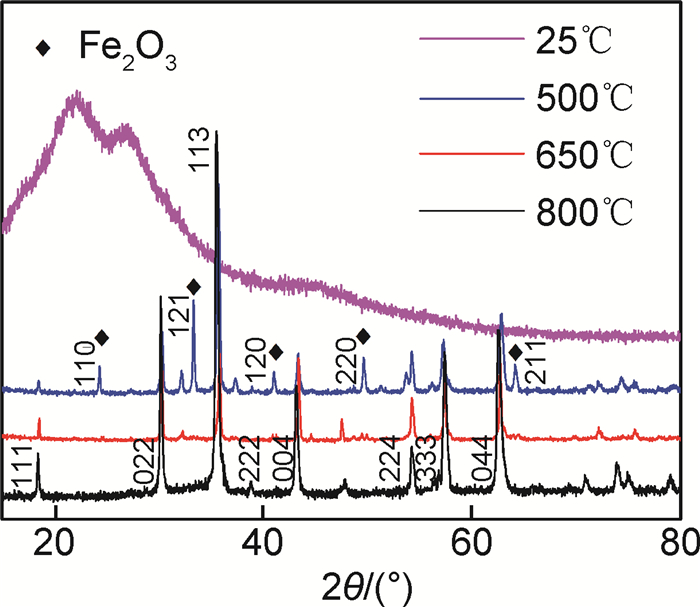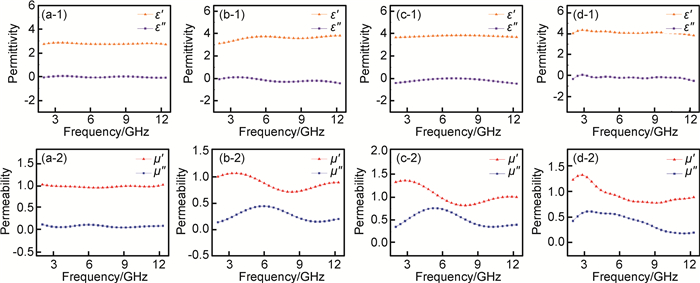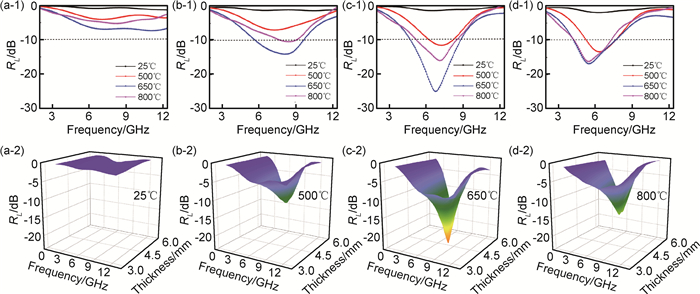文章信息
- 李浩, 毕松, 侯根良, 苏勋家, 李军, 汤进, 林阳阳
- LI Hao, BI Song, HOU Gen-liang, SU Xun-jia, LI Jun, TANG Jin, LIN Yang-yang
- 两步法中煅烧温度对Ni0.5Zn0.5Fe2O4电磁性能的影响
- Effect of calcination temperature on electromagnetic property of Ni0.5Zn0.5Fe2O4 prepared by two-step method
- 材料工程, 2019, 47(1): 64-69
- Journal of Materials Engineering, 2019, 47(1): 64-69.
- http://dx.doi.org/10.11868/j.issn.1001-4381.2017.000340
-
文章历史
- 收稿日期: 2017-03-23
- 修订日期: 2018-09-27
随着现代电子技术的发展,电磁辐射已成为一种新型环境污染公害,另外,随着雷达探测技术的不断发展,武器装备的隐身与突防能力也面临巨大的挑战,因此对电磁波吸收材料的研究显得尤为重要[1-5]。镍锌铁氧体是一种尖晶石结构的软磁材料,它具有介电损耗和磁滞损耗的双重特性,可以作为一种良好的吸波材料,广泛应用于雷达、通信、隐身材料和电子设备[6-10]。当把镍锌铁氧体纳米化,其可以利用纳米材料的粒径小、化学活性好、表面效应强等优点而改善其电磁性质,提高其吸波性[11-13]。
共沉淀法可以直接得到化学组分均一的纳米粉体材料,且得到的产物粒度小、分布均匀,在制备纳米镍锌铁氧体上得到了广泛的应用[14-15]。孟凡君等[16]利用共沉淀法合成了BaFe11(Ti0.5Mn0.5)4O19,其粒子尺寸分布较宽,但尺寸小于100nm,试样在9.2~12.2GHz频段有效吸波(-10dB以上吸波);Li等[17]用共沉淀法制备了Ni-B包裹活化的Fe3O4纳米粒子,在2~18GHz频段有效吸波频宽达到4.6GHz。而溶胶-凝胶法在制备纳米粉体时,样品有很高的均匀性,特别是在进行掺杂时,可实现分子水平的均匀掺杂[18-20]。焦明春等[21]采用溶胶-凝胶法合成了Cu0.2Ni0.8Fe2O4,粒径47nm,在8~12GHz频段最大吸收值为-13.3dB;周克省等[22]利用溶胶凝胶法合成了Ba3(MnZn)xCo2(1-x)Fe24O41,样品有效吸波频宽为3.8GHz;Mu等[23]利用溶胶-凝胶法制得的BaFe12O19粒径为80nm,与Mn-Co-Zr合金混合后,小于-10dB的频宽有4GHz。综合共沉淀法以及溶胶-凝胶法在制备铁氧体时的优点,本工作采用共沉淀法联合溶胶-凝胶法制备纳米Ni0.5Zn0.5Fe2O4复合吸波材料,改变样品在结晶时的煅烧温度,探究了煅烧温度对样品物相组分、微观结构以及电磁性能的影响。
1 实验材料及方法 1.1 实验过程首先利用化学共沉淀法制备铁氧体的前驱体。将5g FeCl2·4H2O以及17.5g NaOH分别溶解于25mL以及100mL蒸馏水,将FeCl2溶液保持在常温下慢速搅拌,然后将加热到50℃的NaOH溶液快速倒入FeCl2溶液中,迅速生成Fe(OH)2沉淀,使混合溶液保持在40℃持续搅拌。称取0.88g Zn(NO3)2和0.86g Ni(NO3)2(均占其总添加量的30%),分别溶解于25mL蒸馏水,然后将Zn(NO3)2溶液逐滴滴加到混合液中(大约滴加2h),滴加完毕继续搅拌1h,然后按同样速率逐滴滴加Ni(NO3)2溶液,滴加完毕后继续搅拌反应5h。然后将混合液离心分离,用蒸馏水洗涤沉淀物至滤液呈中性,将沉淀物置于80℃烘箱中干燥得到前躯体。
在溶胶-凝胶过程中,首先将制备的前躯体加入到25mL蒸馏水中,微波震荡30min备用。称取2g Ni(NO3)2和2.05g Zn(NO3)2一起加入到50mL蒸馏水中,搅拌至完全溶解。然后称取柠檬酸5.65g,加入到混合溶液中,用氨水调节溶液pH值为6。当对混合液加热搅拌形成溶胶时倒入振荡分散后的前驱体乳液中,继续加热搅拌直至形成干凝胶。然后将干凝胶等分为4份,第一份置于室温环境(25℃),其余3份分别在500,650℃和800℃下煅烧2h,其中煅烧时升温速率均为100℃/s,煅烧结束后在同样的环境下冷却至室温,最终得到镍锌铁氧体。
1.2 样品表征制备好的样品利用Rigaku Ultima Ⅳ型X射线衍射仪进行物相表征,扫描条件为铜靶,靶电压40kV,扫描范围为15°~80°,扫描速率为4(°)/min,步进扫描,每步0.02°。利用SPA400型原子力显微镜对样品微观结构进行观察,利用蒸馏水对样品进行分散。最后,利用矢量网络分析仪(KEYSIGHT E5071C)对样品在2~12.4GHz范围之间的介电常数与磁导率进行了测试。
2 结果与讨论图 1为干凝胶在不同温度下煅烧得到的4种样品XRD图。从图 1中可以看出,在25℃下放置未经煅烧的样品结晶不明显,未得到Ni0.5Zn0.5Fe2O4晶体;在650℃和800℃下煅烧得到的样品特征衍射峰与Ni0.5Zn0.5Fe2O4的标准图谱几乎完全一致,得到了纯的Ni0.5Zn0.5Fe2O4;而当煅烧温度为500℃时,不仅出现了Ni0.5Zn0.5Fe2O4的特征衍射峰,还出现了Fe2O3的特征衍射峰,表面制备的Ni0.5Zn0.5Fe2O4样品中还存在有Fe2O3杂质。得出结论,当煅烧温度大于650℃时,可以得到纯的Ni0.5Zn0.5Fe2O4。

|
图 1 不同温度下煅烧样品XRD图 Fig. 1 XRD spectra of samples prepared at different calcination temperatures |
由XRD分析可知在煅烧温度为500,650℃以及800℃时,样品出现结晶,因此利用原子力显微镜对这3种温度下的样品进行观察,得到样品微观图如图 2所示。由图 2(a)可以看出,当煅烧温度为500℃时,样品颗粒平均直径为95nm左右;如图 2(b)所示,当煅烧温度为650℃时,样品颗粒平均直径为54nm左右;如图 2(c)所示,当煅烧温度为800℃时,样品颗粒平均直径为47nm左右。由不同温度下样品的三维示意图可以看出,煅烧温度越高,样品的颗粒粒径越趋均匀。

|
图 2 不同煅烧温度下样品原子力显微镜图 (a)500℃;(b)650℃;(c)800℃ Fig. 2 AFM figures of the samples prepared at different calcination temperatures (a)500℃; (b)650℃; (c)800℃ |
图 3为不同煅烧温度下样品在2~12.4GHz频段内的介电常数与磁导率。由图 3(a-1)~(d-1)可以看出,随着煅烧温度的增大,样品介电常数实部逐渐增大,煅烧温度为800℃时,介电常数实部最大为4.2左右,而介电常数虚部随温度升高无明显变化。由图 3(a-2)~(d-2)可以看出,随着煅烧温度的提高,样品磁导率实部始终在1附近变化,而随煅烧温度的增加,样品的磁导率虚部逐渐增大。

|
图 3 不同煅烧温度下样品介电常数与磁导率图 (1)介电常数图;(2)磁导率图; (a)25℃; (b)500℃; (c)650℃; (d)800℃ Fig. 3 Permittivity and permeability figures of the samples prepared at different calcination temperatures (1)permittivity figures; (2)permeability figures; (a)25℃; (b)500℃; (c)650℃; (d)800℃ |
微波反射衰减率RL反映了材料在理想金属表面对电磁波吸收能力,其中

|
(1) |
输入阻抗

|
(2) |
式中:f为电磁波频率;c为光速;d为样品厚度;μr和εr分别为材料的介电常数与磁导率[24-26],因此得到4种样品在2~12.4GHz范围内微波吸收性能如图 4所示。从图 4(b-1),(b-2)可以看出,当材料厚度为4mm时,650℃下煅烧得到的样品在5.2~9.7GHz频段有效吸波,吸波频带为4.5GHz,800℃下煅烧的样品在7.5~9.0GHz频段有效吸波。从图 4(c-1),(c-2)可以看出,在厚度为5mm时,650℃下煅烧得到的样品在4.6~8.9GHz有效吸波,有效吸波频带最宽,且有最大吸波强度,达到-24.94dB。由图 4(c-1),(c-2)还可以看出,当材料厚度为5mm时,650℃下得到的样品与800℃下得到的样品最大吸波强度均在-17.11dB左右,但是650℃下得到的样品其有效吸波频宽要更大。如图 4(a-2)~(d-2)为4种温度下样品的吸波性能三维图,对比可以直观地发现,当煅烧温度为650℃时,样品的吸波强度以及吸波频宽均最佳,当在常温下未煅烧时(25℃),样品吸波性能最差。图 5为不同煅烧温度下得到的样品不同厚度下有效吸波频宽(≤-10dB),其中横轴代表样品厚度,纵轴代表微波频段。随着材料厚度的增加,其有效吸波频段向低频方向移动,而当煅烧温度为650℃时,在不同厚度下,样品的有效吸波频段均最宽。得出结论,在650℃下煅烧得到的样品,其吸波性能要明显优于500℃以及800℃下煅烧样品的吸波性能。

|
图 4 不同煅烧温度下样品微波吸收性能图 (1)二维吸波性能图;(2)三维吸波性能图; (a)3mm; (b)4mm; (c)5mm; (d)6mm Fig. 4 Microwave absorption ability figures of samples prepared at different calcination temperatures (1)two-dimensional wave absorption abilities; (2)three-dimensional wave absorption abilities; (a)3mm; (b)4mm; (c)5mm; (d)6mm |

|
图 5 不同煅烧温度下样品的有效吸波范围图 Fig. 5 Qualified absorption bandwidth of the samples prepared at different calcination temperatures |
结合样品XRD以及AFM分析结果,4种样品电磁性能的差异可能与样品物相成分以及微观结构有关。在25℃时,样品处于干凝胶状态,未能结晶形成Ni0.5Zn0.5Fe2O4纳米粉体,因此样品电磁性能也最差;在煅烧温度为500℃时,样品结晶有Ni0.5Zn0.5Fe2O4形成,但也出现了Fe2O3杂质,对样品的电磁性能产生影响;在煅烧温度大于650℃时,样品结晶完全,均能够得到纯Ni0.5Zn0.5Fe2O4纳米粉体,且样品颗粒均为纳米粒子。但在相同的升温速率(100℃/s)以及降温环境下,650℃以及800℃下得到的样品微观结构有所差异,800℃下样品的颗粒粒径相对更小,趋于细小化、均匀化。同时,650℃下样品颗粒近似为椭球形,而800℃下样品颗粒近似为球形。然而,制备的Ni0.5Zn0.5Fe2O4复合材料为铁磁性材料,结合图 3(c-2),(d-2)进行对比分析,800℃下样品的复磁导率相对比650℃下样品的复磁导率略有降低,表明800℃的热处理温度一定程度地削弱了Ni0.5Zn0.5Fe2O4材料的磁性,从而对制备样品的吸波性能产生影响。
3 结论(1) 当煅烧温度为500℃时,不仅得到Ni0.5Zn0.5Fe2O4晶体,样品中还出现Fe2O3;当煅烧温度大于650℃时,样品结晶完全,能够得到纯的Ni0.5Zn0.5Fe2O4样品。
(2) 在2~12.4GHz范围内,当煅烧温度为650℃时,样品的微波吸收性能相对更为优异,最大吸波强度达到-24.94dB,有效吸波频带为4.6~8.9GHz,有效频宽达到4.3GHz。
| [1] | BI S, MA L, MEI B, et al. Silicon carbide/carbon nanotube heterostructures:Controllable synthesis, dielectric properties and microwave absorption[J]. Adv Powder Technol, 2014, 25 (4): 1273–1279. DOI: 10.1016/j.apt.2014.03.001 |
| [2] | LIU J, CAO M S, LUO Q, et al. Electromagnetic property and tunable microwave absorption of 3D nets from nickel chains at elevated temperature[J]. ACS Applied and Materials Interfaces, 2016, 8 (34): 22615–22622. DOI: 10.1021/acsami.6b05480 |
| [3] | CAO M S, YANG J, SONG W L, et al. Ferroferric oxide/multiwalled carbon nanotube vs polyaniline/ferroferric oxide/multiwalled carbon nanotube multiheterostructures for highly effective microwave absorption[J]. ACS Applied and Materials Interfaces, 2012, 4 (12): 6948–6955. |
| [4] | HE J Z, WANG X X, ZHANG Y L, et al. Small magnetic nanoparticles decorating reduced graphene oxides to tune electromagnetic attenuation capacity[J]. Journal of Materials Chemistry C, 2016, 4 (29): 7130–7140. DOI: 10.1039/C6TC02020H |
| [5] | JI K K, LI Y, CAO M S. Mn, Ti substituted barium ferrite to tune electromagnetic properties and enhanced microwave absorption[J]. Journal of Materials Science:Materials in Electronics, 2016, 27 (5): 5128–5135. DOI: 10.1007/s10854-016-4404-x |
| [6] | LI Y, CAO M S. Enhanced electromagnetic properties and microwave attenuation of BiFeO3-BaFe7(MnTi)2.5O19 driven by multi-relaxation and strong ferromagnetic resonance[J]. Materials and Design, 2016, 110 : 99–104. DOI: 10.1016/j.matdes.2016.07.119 |
| [7] | MOAYAD H F, SAHRIM H A, MUSTAFFA H A, et al. Preparation, thermal, magnetic and microwave absorption properties of thermoplastic natural rubber matrix impregnated with NiZn ferrite nanoparticles[J]. Composites Science and Technology, 2014, 96 (25): 103–108. |
| [8] | KHAIRY M. Synthesis, characterization, magnetic and electrical properties of polyaniline/NiFe2O4 nanocomposite[J]. Synth Metals, 2014, 189 : 34–41. |
| [9] | ZHAO C Y, SHEN M Y, LI Z X, et al. Green synthesis and enhanced microwave absorption property of reduced graphene oxide-SrFe12O19 nanocomposites[J]. J Alloys Compd, 2016, 689 : 1037–1043. DOI: 10.1016/j.jallcom.2016.08.078 |
| [10] | ZHANG H, HONG M, CHEN P, et al. 3D and ternary rGO/MCNTs/Fe3O4 composite hydrogels:synthesis characterization and their electromagnetic wave absorption properties[J]. J Alloys Compd, 2016, 665 : 381–387. DOI: 10.1016/j.jallcom.2016.01.091 |
| [11] | KHADIJEH D, ELHAM Y, FARSHID N A, et al. Radar absorption properties of Ni0.5Zn0.5Fe2O4/PANI/epoxy nanocomposites[J]. J Chin Chem Soc, 2015, 62 (9): 826–831. DOI: 10.1002/jccs.201500136 |
| [12] |
景红霞, 李巧玲, 叶云, 等. 纳米Fe3O4及Fe3O4-SrFe12O19吸波复合材料的制备及性能[J].
复合材料学报, 2013, 30 (1): 130–134.
JING H X, LI Q L, YE Y, et al. The preparation and characterize of Fe3O4 and Fe3O4-SrFe12O19 macrowave absorbing composite materials[J]. Acta Materiae Compositae Sinica, 2013, 30 (1): 130–134. |
| [13] | GHAZZAWY E H, AMER M A. Structural, elastic and magnetic studies of the as-synthesized Co1-xSrxFe2O4 nanoparticles[J]. J Alloys Compd, 2017, 690 : 293–303. DOI: 10.1016/j.jallcom.2016.08.135 |
| [14] | ALBUQUERQUE A S, ARDISSON J D, MACEDO W A, et al. Nanosized powders of NiZn ferrite:synthesis, structure, and magnetism[J]. J Appl Phys, 2000, 87 (9): 4352–4356. DOI: 10.1063/1.373077 |
| [15] |
毕杰, 李海波, 刘梅, 等. 纳米Co1-xZnxFe2O4/SiO2复合材料的结构和磁性[J].
复合材料学报, 2010, 27 (6): 126–129.
HUA J, LI H B, LIU M. Structure and magnetic properties of nano-Co1-xZnxFe2O4/SiO2 composites[J]. Acta Materiae Compositae Sinica, 2010, 27 (6): 126–129. |
| [16] |
孟凡君, 茹淼焱, 刘爱祥, 等. 替代M型钡铁氧体纳米粒子的微波吸收性能[J].
无机化学学报, 2002, 18 (10): 1067–1670.
MENG F J, RU M Y, LIU A X. The micro wave absorption properties of replace M-Ba-ferrite[J]. Joural of Inorganic Chemistry, 2002, 18 (10): 1067–1670. DOI: 10.3321/j.issn:1001-4861.2002.10.021 |
| [17] | LI X A, HAN X J, TAN Y J. Preparation and microwave absorption properties of Ni-B al-loy-coated Fe3O4 particles[J]. J Alloys Compd, 2008, 464 (1): 352–356. |
| [18] | LI Z J, HOU Z L, SONG W L, et al. Unusual continuous dual absorption peaks in Ca-doped BiFeO3 nanostructures for broadened microwave absorption[J]. Nanoscale, 2016, 8 (19): 10415–10424. DOI: 10.1039/C6NR00223D |
| [19] | GHASEMI A, MORSAKO K. Static and high frequency magnetic properties of Mn-Co-Zr substituted Ba-ferrite[J]. J Alloys Compd, 2008, 456 (1): 485–491. |
| [20] |
孙银凤, 李国栋, 张常在, 等. 稀土Z型铁氧体Ba3-xCexCo2Fe24O41的制备及其微波吸收性能[J].
中国稀土学报, 2004, 24 (增刊2): 152–155.
SUN Y F, LI G D, ZHANG C Z, et al. Synthesis andmicrowave absorbing properties of Z-type hexaferrite Ce-doped Ba3-xCexCo2Fe24O41[J]. Journal of the Chinese Rare Earths Society, 2004, 24 (Suppl 2): 152–155. |
| [21] |
焦明春, 李国栋. 纳米镍铜铁氧体粒子的制备与微波吸收特性研究[J].
功能材料, 2005, 36 (2): 295–297.
JIAO M C, LI G D. Manufacturing nano-ferrite particles and research of its microwave absorption properties[J]. Journal of Functional Materials, 2005, 36 (2): 295–297. DOI: 10.3321/j.issn:1001-9731.2005.02.042 |
| [22] |
周克省, 陈颖, 秦宪明, 等. Z型铁氧体Ba3(MnZn)xCo2(1-x)Fe24O41的微波吸收性能[J].
功能材料, 2011 (10): 1810–1813.
ZHOU K S, CHEN Y, QIN X M, et al. Microwave absorb ing properties of Z-type ferrite Ba3(MnZn)xCo2(1-x)Fe24O41[J]. Journal of Functional Materials, 2011 (10): 1810–1813. |
| [23] | MU G H, SHEN H G, QIU J X. Micro wave absorption properties of composite powders with low density[J]. Applied Surface Science, 2006, 253 (4): 2278–2281. DOI: 10.1016/j.apsusc.2006.04.021 |
| [24] | SUN X, HE J P, LI G X, et al. Laminated magnetic graphene with enhanced electromagnetic wave absorption properties[J]. J Mater Chem C, 2013, 1 (4): 765–777. DOI: 10.1039/C2TC00159D |
| [25] | SONG W L, GUAN X T, FAN L Z, et al. Turning three-dimensional textures with graphene aerogels for ultra-light flexible graphene/texture composites of effective electromagnetic shielding[J]. Carbon, 2015, 93 : 151–160. DOI: 10.1016/j.carbon.2015.05.033 |
| [26] | SONG W L, WANG J, FAN L Z, et al. Interfacial engineering of carbon nanofiber-graphene-carbon nanofiber heterojunctions in flexible lightweight electromagnetic shielding networks[J]. ACS Appl Mater Interface, 2014, 6 (13): 10516–10523. DOI: 10.1021/am502103u |
 2019, Vol. 47
2019, Vol. 47


